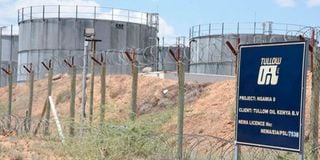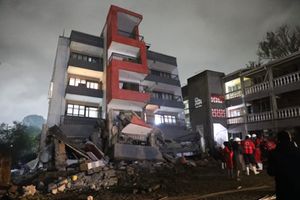Sh2.4bn for Lokichar-Lamu crude oil pipeline preparatory work

Tullow Oil facility at Ngamia 8 in Lokichar, Turkana County, on February 18, 2020. The State has apportioned Sh2.4 billion over the next three financial years for preparatory work for the Lokichar-Lamu crude oil pipeline, signalling a determination to tap oil cash.
The State has apportioned Sh2.4 billion over the next three financial years for preparatory work for the Lokichar-Lamu crude oil pipeline, signalling a determination to tap oil cash.
A budget schedule by the National Treasury showed that Sh651.26 million has been apportioned for research, feasibility studies, project preparation, and design of the pipeline in the new financial year starting in July.
Funding for the preparatory activity on the planned crude pipeline will rise to Sh872.68million and Sh878.35million in the 2024/25 and 2025/26 fiscal years, respectively—marking renewed financing for the venture that wasn’t allocated any cash in the current financial year.
The country first announced the discovery of oil in March 2012 within the Lokichar Basin in Turkana County but is yet to fully exploit it commercially.
Early Oil Pilot Scheme
The country in August 2019 waved off its first consignment of crude from the Mombasa port under its Early Oil Pilot Scheme (EOPS). British oil explorer Tullow earlier this year disclosed that it made $ 4 million (Sh549,94million) from the sale of Kenyan oil in the two years when the firm made pilot exports to test the market appeal of the commodity.
Tullow, with its joint venture partners in the Kenya oil project, Total and Africa Oil started the shipments on June 3, 2018, and lifted 240,000 barrels of Kenya crude in two years before the scheme was ended.
The British exploration firm and its partners in March this year submitted a revised field development plan (FDP) to the government for approval, as the venture stepped up its search for a strategic investor to help with the commercialization of the Kenya oil project.
The approval of the FDP—which will need to be ratified by Parliament —will enable the venture to get a government license to commence commercial drilling of crude oil in the 10BB and 13T oil blocks in Turkana County.
While the initial FDP was submitted in December 2021, the revised plan follows the revelation that the commercially recoverable oil from the reserves is significantly larger than previously estimated.
An audit by British petroleum consulting firm Gaffney, Cline & Associates led the firms to revise the production capacity of the oilfields to 120,000 barrels of oil per day (bopd), up from previous estimates of 70,000 bopd.
This saw the revision of the FDP that has increased the size of the crude oil processing facility in Turkana and the size of the pipeline to evacuate the oil to Lamu, increasing the projected cost of the project from Sh319 billion to Sh377 billion.
The revised FDP also increased the diameter size of the planned Lokichar-Lamu crude oil pipeline from 18 inches to 20 inches to handle a higher product volume and drilling of additional exploration wells.
Besides the renewed interest in the Lamu-Turkana crude pipeline, the State has stepped up its new petroleum exploration campaign on Block 14T in the Magadi Basin with a combined Sh862 million budget over the next three years as the country hopes to strike more oil reserves.
A budget schedule by the Treasury showed that exploration work on the block would be heightened over the next three years with substantial funding allocated from the new financial year starting July. The exploration work on the bloc will get Sh280 million for 2023/2024 before rising to Sh290 million and Sh292 million in the next two successive fiscal years, successively.
The stepped-up campaign on the Magadi Basin comes barely two years after the National Oil Corporation of Kenya (Nock) concluded a Magnetotelluric (MT) exercise on the basin in 2021—an exercise that was aimed at gathering more data on potential petroleum reserves and help in the identification of drill-able prospects in the block.
Nock has been conducting oil exploration activities within the southern part of Block 14T that stretches from Kajiado, Narok to Nakuru and Baringo counties.
The exploration block runs from the shores of Lake Bogoria down to Lake Magadi Basin on the border of Kenya and Tanzania.





